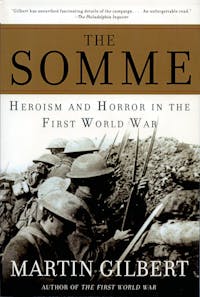The Somme
Herosim and Horror in the First World War
 Download image
Download image
ISBN10: 0805083014
ISBN13: 9780805083019
Trade Paperback
368 Pages
$21.00
At 7:30 in the morning on July 1, 1916, tens of thousands of Allied soldiers advanced across no-man's land north and south of the Somme River in France toward the barbed wire and machine guns of the German front lines.
By the end of this first day of the Allied attack, the British army alone had lost 20,000 men. In the coming four and a half months, the fifteen-mile stretch of fields and villages along the Somme became the epicenter of the Great War. This desperate battle was a turning point in both the war and in military history, as the combatants saw the first appearance of tanks on the battlefield, the emergence of air war as a formidable factor in battle, and more than one million casualties (among them a young Adolf Hitler, who was wounded in the leg). In just 138 days of fighting, an average of more than 2,000 men per day were killed, 310,000 in all. The Allied forces alone lost nearly 150,000 men. And not one of the Allied objectives of the first day was reached.
In this researched account of one of history's longest and most destructive military confrontations, the distinguished historian Martin Gilbert tracks the Battle of the Somme through the experiences of foot soldiers (known to the British as the PBI, for Poor Bloody Infantry), generals, aviators, artillerymen, and nurses. Interwoven with outstanding photographs, journal entries, maps, and documents from every stage and level of planning, The Somme is an account of this bloody turning point in the Great War.
Reviews
Praise for The Somme
"What is most moving in [Gilbert's] account is the way he punctuates each part of the narrative with the tale of a single soldier's experience, a short biography that captures a lost life in surviving words . . . Easily achieves his modest goal of 'perpetuating the memory of those who fought and those who fell.'"—Robert Messenger, The Weekly Standard
"Ninety years ago, Allied soldiers clambered into no-man's land and charged the Germans at the Somme; 20,000 British soldiers would die in a single day, and 300,000 soldiers were lost on both sides in the next several months. A noteworthy historian offers what should be the definitive account."—Library Journal
"The Great War is now viewed by many as a pointless, pitiless meat grinder that sacrificed a generation of men to no worthwhile moral purpose. If one accepts that premise, then the Battle of the Somme can serve as exhibit A. Ninety years ago, Allied (primarily British) and German troops began a five-month slugfest in northwest France. The battle, which saw the first widespread use of tanks, was contested by two million troops along a 30-mile front. When it was over, it had cost both sides a combined million casualties, with virtually no territorial gain. Gilbert, a renowned historian and biographer, utilizes the journals and memoirs of the participants to convey the savagery and horror of the battle, and he also effectively explains how the battle fit into the broader strategic objectives of the adversaries. At times, the relentless slaughter conveyed in Gilbert's narrative is mind numbing, but this is a masterful work that should be read by anyone who wishes to understand the futility of the 'war to end all wars.'"—Jay Freeman, Booklist
"The four-month–long battle of the Somme epitomized the futile bloodletting on the western front, with 19,000 advancing British soldiers killed by the Germans on the very first day. From the impersonality of this mechanized slaughter, Gilbert, dean of First and Second World War historians, strives to recover the pathos of personal experience by spotlighting the exploits and travails of various small units and individual soldiers, mostly on the British side. He brings them to life through firsthand accounts, reminiscences by comrades, poignant letters home and snatches of soldiers' poetry, always ending his vignettes with a notice of where the soldiers discussed lie buried—or at least memorialized, since the bodies of 73,000 of the dead were never identified. (Many excellent, very detailed maps of both the battlefield and the resulting cemeteries are included.) . . . His superbly written, absorbing recreations of innumerable small life-and-death struggles makes the book a fitting commemoration of the tragedy."—Publishers Weekly
Reviews from Goodreads
BOOK EXCERPTS
Read an Excerpt
Prelude
‘Chewing barbed wire'
In August 1914 the empires of Europe embarked on a war that each of them believed would be swift and victorious.
Austria–Hungary was confident it could crush Serbia within a few weeks,...



